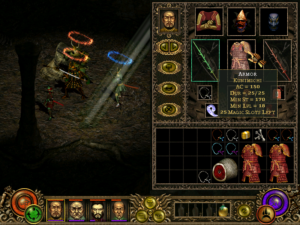Throne of Darkness: Words
I haven’t mentioned that objects in this game tend to have Japanese names. That is, you don’t get a two-handed sword and a full helmet, you get a nodachi and a kabuto. I was pleased to see the word “kanmuri” used for one of the weakest helmets, as I had seen this word before in a completely different context: in writing Japanese characters, a kanmuri is a radical that goes on top. Apparently it means “crown”. It’s all a little reminiscent of playing the Samurai class in Nethack, with its name substitutions for items, but in Nethack only a few items are covered, and here it’s nearly everything.
 Some of these words have already percolated through gamer culture (is there anyone who doesn’t know what a shuriken is?), others have not. (What on earth is a shinjyu? Or a ka-ho? 1Answers: The “shinjyu” in the game, an enchanted string of beads, is probably 真珠, which means “pearl”. There’s also an item-enhancement component called a “pearl”, but I think that’s just a result of the developers not paying much attention to translations when they were choosing names. “Ka-ho” in the game is a gem that enhances your stats, and is probably 果報, “good luck”. ) Some may be made up or misapplied: the strongest armor in the game is called “kunimichi”, which googles primarily as the name of a famous swordsmith. I suppose that there aren’t any famous armorsmiths, and they ran out of real armor terms. (They ran out of monster names too, but solved that with the time-honored gimmick of shoving prefixes in front of everything: Forest Oni, Fire Oni, etc.)
Some of these words have already percolated through gamer culture (is there anyone who doesn’t know what a shuriken is?), others have not. (What on earth is a shinjyu? Or a ka-ho? 1Answers: The “shinjyu” in the game, an enchanted string of beads, is probably 真珠, which means “pearl”. There’s also an item-enhancement component called a “pearl”, but I think that’s just a result of the developers not paying much attention to translations when they were choosing names. “Ka-ho” in the game is a gem that enhances your stats, and is probably 果報, “good luck”. ) Some may be made up or misapplied: the strongest armor in the game is called “kunimichi”, which googles primarily as the name of a famous swordsmith. I suppose that there aren’t any famous armorsmiths, and they ran out of real armor terms. (They ran out of monster names too, but solved that with the time-honored gimmick of shoving prefixes in front of everything: Forest Oni, Fire Oni, etc.)
To the extent that they refer to unknown things, the Japanese names are an obstacle to understanding. I’ve noticed before that I generally have an easier time getting used to the relative power of things in fantasy games than in sci-fi games, because “dragon” and “unicorn” are extremely clear and distinct ideas in my mind, while “photon cannon” and “tachyon beam” both get filed under technobabble. Similarly, even though I’ve studied Japanese a little, this game is full of what I can only see as Japanobabble. To someone learned in traditional Japanese martial technology, the difference between a “shibata” and a “nisun nobi” might be obvious. Me, all I have to go on is the pictures. They both look like bows.
But I suppose it’s educational. At least, in those cases where they didn’t just make up the words or assign them arbitrarily.
| ↑1 | Answers: The “shinjyu” in the game, an enchanted string of beads, is probably 真珠, which means “pearl”. There’s also an item-enhancement component called a “pearl”, but I think that’s just a result of the developers not paying much attention to translations when they were choosing names. “Ka-ho” in the game is a gem that enhances your stats, and is probably 果報, “good luck”. |
|---|
 Comments(0)
Comments(0)